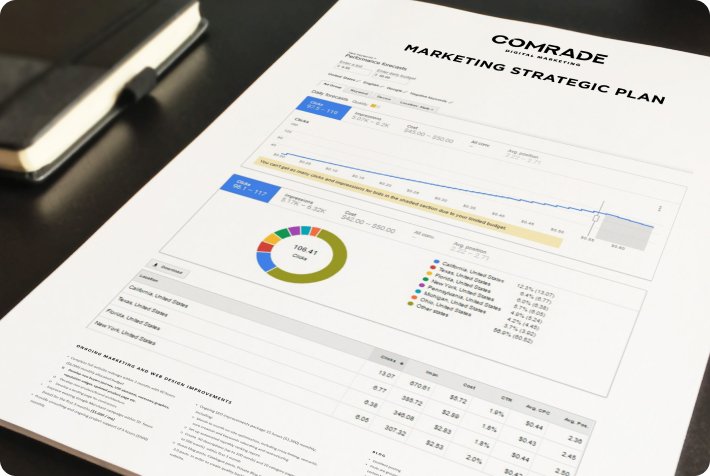What Is Ecommerce Email Marketing?
eCommerce email marketing is a form of direct marketing that uses email to promote products and services. It involves creating targeted email campaigns for specific segments of customers, such as those who have recently made a purchase or who have shown an interest in a certain product.
The goal is to nurture relationships with customers and encourage them to make repeat purchases. This is done by sending targeted emails that are tailored to the customer’s interests, such as special offers and discount codes.
Why Is Email Marketing Important for Ecommerce?
Email marketing is an essential tool for any eCommerce business. It allows you to connect with potential customers, build relationships, and drive sales. It’s an effective way to reach a large audience quickly and cost-effectively. With email marketing, you can target specific segments of customers based on their interests and needs. You can also send personalized messages to your new subscribers, thus getting more repeat customers.
Email marketing helps you stay engaged with your customers over time, allowing you to nurture leads into long-term customers. Finally, email marketing allows you to evaluate the effectiveness of your efforts so you can make the necessary adjustments to your strategies. With all these benefits, it’s no wonder that email marketing is so important for eCommerce businesses.
Target Audience Segmentation
Because you can tailor emails to reflect the specific needs and wants of your audience, every email you send will be relevant to them, regardless of where they are in the buyer’s journey. According to the data, targeted emails maintain a 50% higher click-through rate (CTR) than untargeted campaigns.
Consistent Outreach & Increased Awareness
Maintaining mind share (consumer awareness) is a persistent challenge for all eCommerce businesses. Email marketing is an easy way to stay in touch with existing customers and leads that have entered the sales funnel. Implementing strategic drip campaigns ensures your company is top of mind when customers require your products or services.
Cost-Effective With a High ROI
Low costs plus high ROI is an automatic business win. With eCommerce email marketing campaigns, there are no print costs, no postage fees, and no advertising rates. Email marketing brings $40 for every $1 spent, outperforming search, display, and social marketing. A recent study revealed that 85% of US retailers recognize email marketing as the most effective customer acquisition tactic.
Distribution at Scale
With the simple click of a button, your email marketing campaign can reach and influence thousands of people. Email subscribers who share your offers and news with their friends, essentially act as brand advocates. The more recipients distribute your content, the more exposure and credibility your eCommerce store gains.
Metrics That Offer Actionable Data
Another benefit of email marketing is the precise and valuable metrics it provides to measure the eCommerce success of any campaign. Knowing your delivery rates, open rates, click-to-deliver rates, and subscriber retention rates offers interesting insights into your customers’ behavior which you can use to further optimize your campaigns.
7 Types of Email Marketing Every Ecommerce Store Should Use

eCommerce email marketing campaigns can be used to generate sales, enhance customer engagement, raise brand awareness, and reward loyal customers.
For existing clients and customers, email deepens and grows business relationships, whereas, for potential customers, it attracts and nudges them into the sales funnel.
There are many personalized email campaigns you can start to get new subscribers. Use them all at once or just a couple – it’s up to you. Below we list the best of them, so you can be sure that you’re attracting real, paying customers.
1. Welcome Emails
Often part of a series of onboarding emails, a welcome email is the first communication you have with a new shopper or lead after they buy a product or subscribe to your email database. It provides the perfect opportunity to initiate a long-term relationship that moves prospects forward in their buyer’s journey.
74% of customers expect to receive a welcome email. Once they open your message, you have a chance to introduce your brand and values, engage customers with enticing discounts, and set expectations for future communication. A “good” first impression automatically wins over new customers.
2. Loyalty Emails
Encourage customers to return to your online store and make repeat purchases with regular loyalty emails that contain point statements or reminders of available rewards. Customer loyalty emails easily fit into existing email marketing strategies and support customer retention—a core component of successful eCommerce brands.
Did you know loyalty emails perform 14 times better than regular eCommerce emails because they resonate on a personal level? It’s also easy to increase your customer’s average order value by cross-selling and upselling your products and service via these emails.
3. Abandoned Cart Emails
Abandoned cart emails remind customers when they’ve left something in your cart and encourage them to checkout. As much as 75% of lapsed buyers intend to return and complete their purchases, so it’s worthwhile capitalizing on their expressed interest.
The conversion rate for abandoned cart emails is roughly 18%. An email sent within an hour can achieve a rate as high as 20% compared to 12.2% if sent 24 hours later. Generally, these emails help recover 15% of what otherwise would have been lost revenue.
4. Follow-Up Emails
A follow-up email is usually sent after any significant point in the customer journey. These types of emails have the power to convert leads, bring in new business, build customer relationships, and close deals. They’re incredibly effective, but often the least sent.
You might send follow-up emails to thank customers for their business and check they’re happy with their purchases, or to reengage old customers. As a rule of thumb, you should be specific and genuine and have one clear call to action per email.
5. Promotional Emails
Promotional emails drive sales by informing customers of new or existing products. Common email promotions include a coupon code, discount code, or access to exclusive content to move a potential customer through the sales funnel to a conversion.
Marketers deploy these types of emails for a limited time, so recipients feel the need to take immediate action. Interestingly, acquiring a new customer can cost five times more than retaining an existing one. Increasing customer retention by 5% can boost profits from 25% to 95%, and promotional emails are one such way to do so.
6. Newsletter Emails
Newsletter emails provide customers with valuable content and relevant promotions. By connecting with your target audience and informing them alongside selling, you’re ultimately developing brand loyalty and effective long-term relationships.
Besides once-off promotional emails, newsletters provide powerful ways to launch new offerings. Some brands offer new subscribers sneak peeks, discounts, or first dibs on new products. These show customer appreciation and give your audience a clear incentive to stay subscribed.
7. Review Request Emails
Online reviews are helpful to the vast majority of customers, and they secure online visibility in search rankings. Reviews have a longer shelf life than social media posts, and consumers trust them because they’re honest. In fact, 90% of customers read reviews.
Incentivized review request emails have two big benefits: They help increase review collection rates and drive customers back to your online store once they’ve completed their reviews. These valuable reviews can later be used in future newsletters or even on your eCommerce store’s website as social proof.
How to Craft Successful Ecommerce Email Marketing Campaigns

A successful eCommerce email marketing campaign fosters recipient engagement, minimizes unsubscribed, and maintains a strong brand image. Sending the right email at the right time can capture attention, nurture interest, and convert.
Below are a few pointers to get you started on the right track.
Messaging
There are two important aspects to consider when it comes to messaging. Firstly, the tone of your email marketing should match the general tone of your brand. The best-selling book, Email Persuasion, recommends writing emails in an informal style as if you’re chatting to a good business friend over coffee.
Arguably more important than the copy is an email’s subject line. Try to find a happy medium between creativity and getting straight to the point. The purpose of the subject lines is to get recipients to open the email. Stay away from using “clickbait” titles as this provides a poor user experience, and some platforms’ filters may mistake it for spam.
Design
Visual hierarchy is the principle of arranging elements to show their order of importance. You’ll notice most emails put the important information first to grab the attention of those who are short on time. In fact, the majority of consumers don’t read emails; they quickly scan them.
How you organize and layout your email design is just as important as what’s in it. If possible, keep the width to 600 pixels and make sure all your content appears above the fold. Creating responsive emails is also important to ensure they provide a good user experience across mobile devices.
Focus on Conversions
Conversion-centered design guides readers toward action before they lose interest in your marketing emails. Email marketing needs to be cohesive in its singular goal—from the subject line to the call to action. And that goal is to convert.
Some psychological triggers to guide people toward action include:
- Fulfilling the expectation set by the subject line.
- Making CTAs stand out with contrasting colors.
- Using urgency to encourage action.
- Focussing on product and service benefits.
How to Choose the Right Tools to Create Your Email Marketing Campaign
Email marketing software allows you to plan, create, implement, track and monitor the performance of your eCommerce email marketing strategy.
At the most basic level, it should provide the ability to communicate and grow your subscribers by offering tools such as email templates, editors, form builders, schedulers, and auto-responders, as well as analytics and reporting.
There are dozens of email marketing platforms out there, so how do you choose the right one?
1. Ease of Use
Even if you’ve never used email software before, the platform you choose should have clear steps and easy-to-navigate tools that make the process as straightforward as possible.
Naturally, there’s a learning curve with any new platform; however, it should be intuitive and simplistic. Read independent, third-party reviews and take full advantage of any free trial you’re offered before settling on a platform for your eCommerce business.
2. Integrated Analytics
As a business owner, you’re already aware of how important data is for making strategic decisions. Therefore, your email marketing service provider should come with built-in analytics or, at the very least, analytics integration.
Monitoring and reporting are areas where a good deal of email marketing tools fall short, yet concrete data is key to improving and driving future campaigns and more conversions. Because email is one of the main channels of converting website visitors into customers, it’s paramount you have the right data-gathering tools.
3. Easy Automation Options
Automated email campaigns are productive and cost-effective for all businesses, transforming 15-20% of leads into profits. Most small-to-medium-sized companies benefit from connecting their online store’s CRM to their email marketing campaigns.
Some automation features might include: abandoned cart emails, recent purchase emails, drip email campaigns, and birthday or anniversary emails. This allows you to sync your marketing messages with your buyer cycles.
15 Best Tools to Manage Your Email Marketing Campaigns
1. Sendpulse
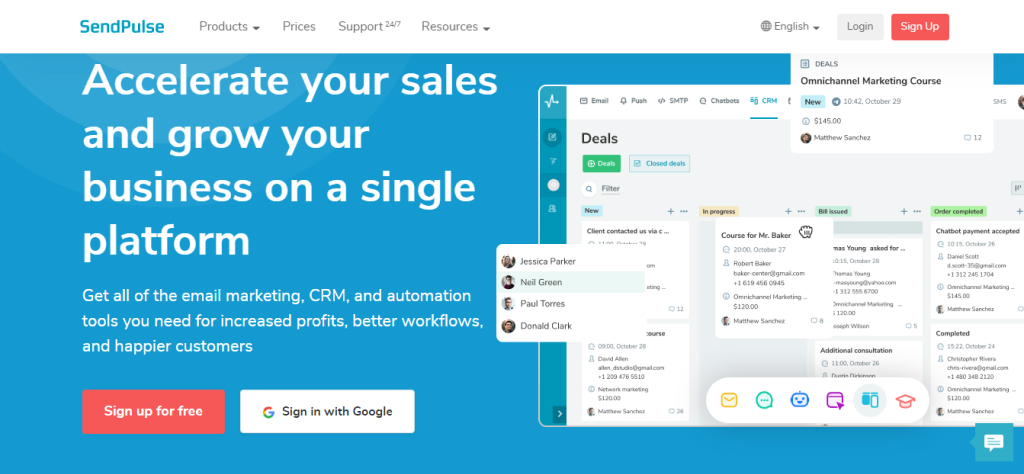
Sendpulse is an all-in-one email marketing solution that’s free—so long as you have fewer than 2,500o subscribers and send fewer than 15,000 emails per month. With it, you can send SMS campaigns, and work with clients using chatbots for Telegram, Facebook Messenger, WhatsApp, and Instagram.
The platform provides businesses with a streamlined messaging ecosystem that allows you to plan your email marketing strategy, segment your audience, conduct A/B tests, send messages and analyze results from a centralized dashboard.
2. Mailerlite
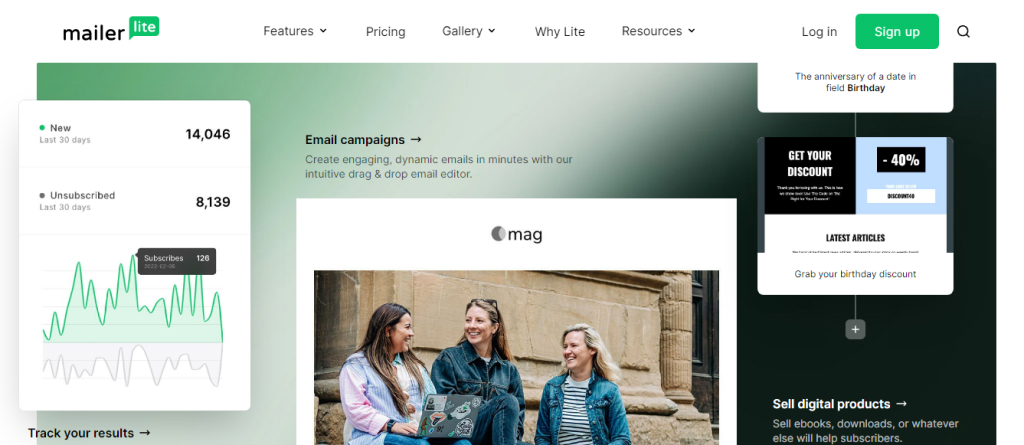
Mailerlite is a user-friendly tool and a great choice for small businesses due to its generous free plan. It lets you send unlimited free emails if you have less than 1,000 subscribers. Once you reach its threshold, you have to upgrade. However, its easy setup, multiple landing page capabilities, and automation features can help you build powerful campaigns in minutes.
The platform offers seamless integration with third-party apps, including Zapier, ProductDyno, WordPress, Shopify, and WooCommerce. Emails created through MailerLite are optimized for smartphone and tablet viewing, ensuring customers can read and consume your content wherever they are.
3. Campayn
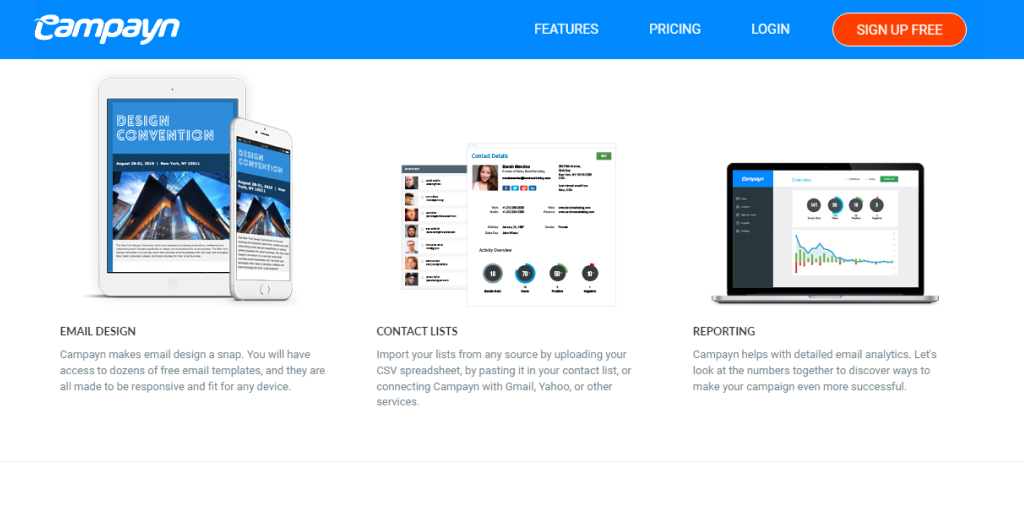
Whether you start from scratch or choose one of their free templates, Campayn’s design theme options make it simple to keep your branding consistent with professional-looking emails. Some of the world’s favorite brands, like Mercedes-Benz, Avon, Airbnb, and Hyatt, use Campayn to deliver polished marketing campaigns to their customers.
The platform is free for companies with fewer than 5,000 subscribers, allowing you to send up to 20,000 emails per month. For users who wish to upgrade, Campayn offers both monthly and pay-as-you-go plans. It packs all the essentials you need into a straightforward and simple drag-and-drop platform.
4. Freshmail
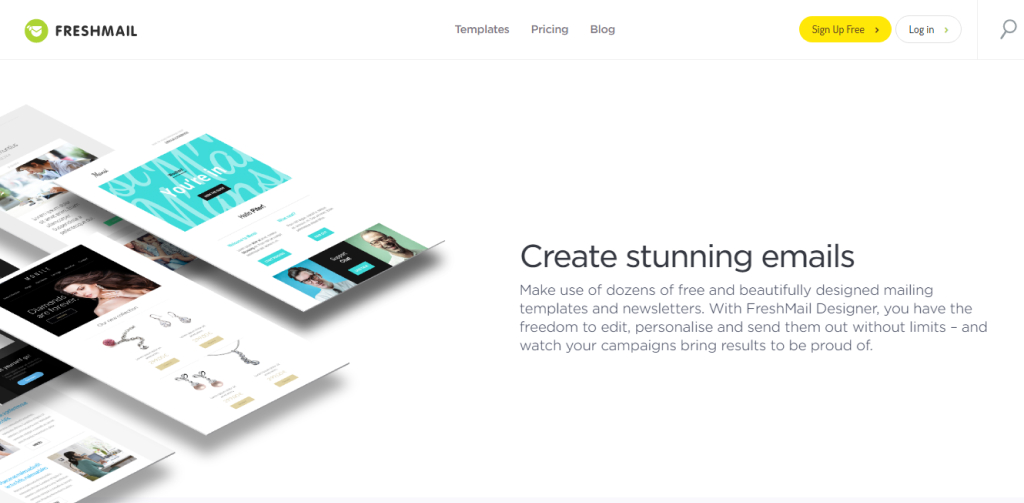
One of the highlights of Freshmail is its ability to track subscriber behavior in real-time. Its marketing automation capabilities let businesses send personalized emails and receive insights into customer responses. Additionally, it enables campaign management via Google Analytics, so you can export relevant reports and view the performance of social links.
Freshmail offers a free version for eCommerce stores with 500 or fewer subscribers, including a 2,000 email allowance. When upgrading, you can choose between pay-as-you-go and a monthly subscription. Designing emails is hassle-free and doesn’t require any coding skills.
5. Mad Mimi
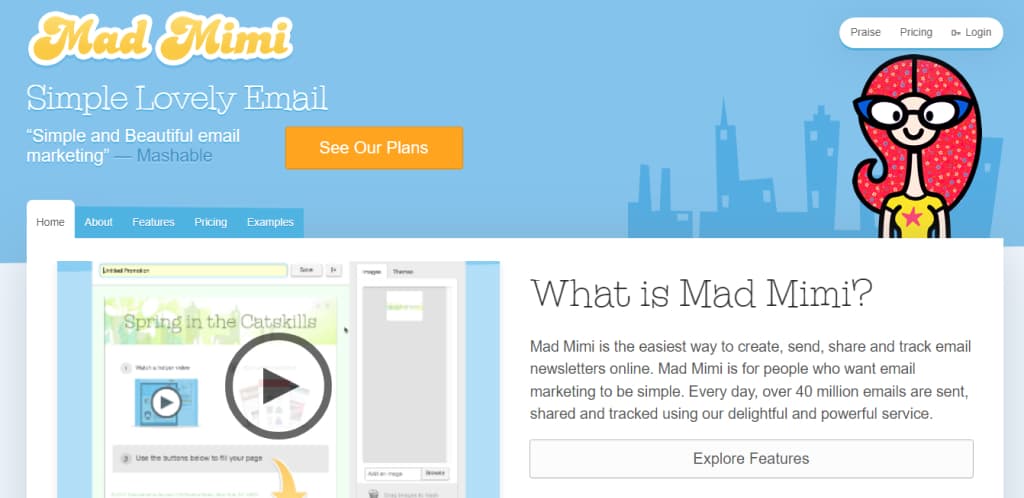
Mad Mimi simplifies email management with automated suppression of bounces and unsubscribes, unlimited lists, segmentation, and much more. Its list management features all live happily on one page, so you never have to run around to find what you’re looking for.
Its upgrade options include Pro, Silver, and Gold plans. For $42, you can purchase the Pro plan, which allows you to maintain a maximum of 10,000 contacts. The Silver plan is $199 and allows you to store up to 50,000 contacts, and the Gold plan costs $1,049 and lets you have up to 350,000 contacts. The Gold plan is typically better suited for larger businesses with large client bases.
6. ActiveCampaign
While not free, ActiveCampaign only costs $9 per month. And it’s more than just an email marketing platform. It offers CRM tools to create seamless customer experiences. This means you can organize and keep all your customer data on one platform, managing multiple pipelines and updating offers according to real-time feedback.
The most basic level of ActiveCampaign allows you to send emails to 500 subscribers. First-time users can try the platform risk-free for 14 days. It’s definitely not the cheapest platform; however, with 870+ integrations like Shopify, WordPress, and Zapier, it does provide all the eCommerce email marketing tools you need to run successful campaigns.
7. Sales-Push
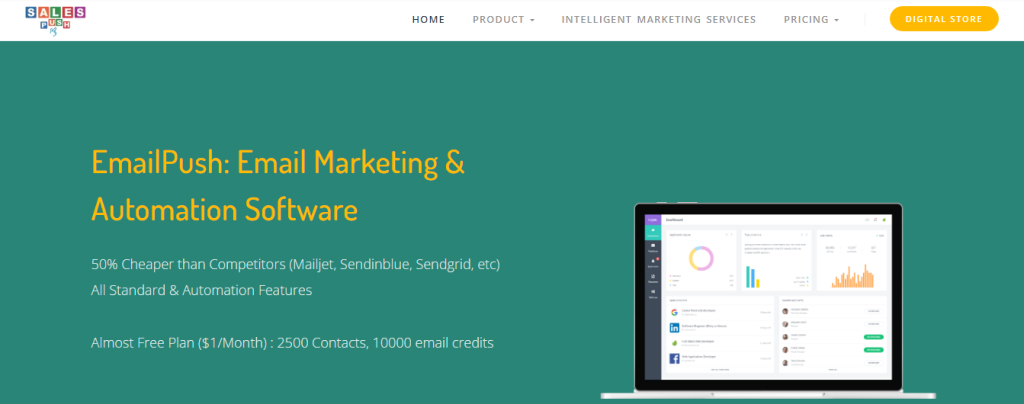
According to Sales-Push, it’s 50% cheaper than its competitors and comes with all the expected automation features you’d expect from industry-standard email marketing martech. Its “almost free” plan ($1 per month) permits 2,500 contacts and 1,000 email credits. Like other platforms, Sales-Push offers subscriber-based monthly plans where you have to pay for the number of contacts, or you can opt for a volume-based plan that allows you to purchase email credits.
With over 700 different customizable template versions available, you’re bound to find something for your eCommerce brand. Other noteworthy highlights include list segmentation and in-depth analytics. You can also personalize emails with your customers’ names and countries, add social media widgets and insert JavaScript to take full advantage of your email communication.
8. Benchmark Email
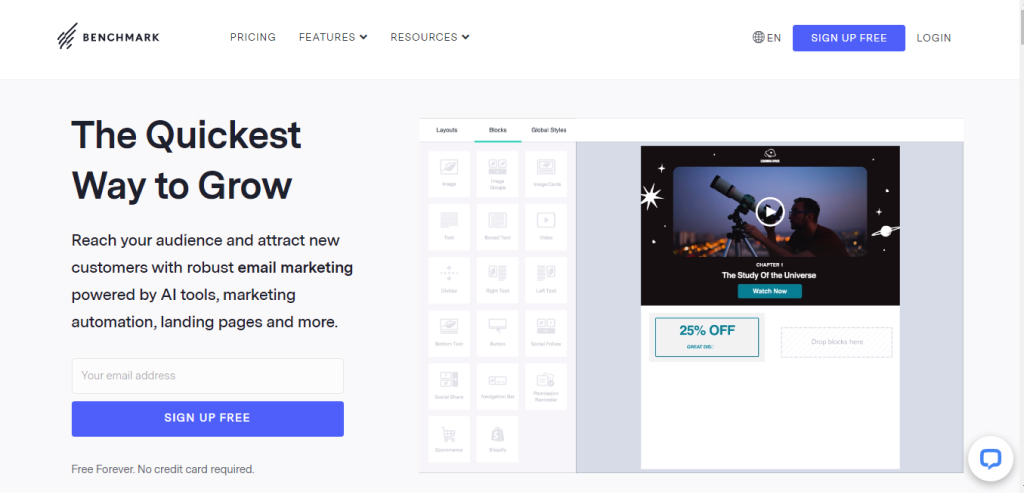
Benchmark is an easy-to-use email marketing and automation platform that lets you quickly build eye-catching emails with its drag-and-drop builder. Growing your subscriber list is simple with its landing pages, forms, and survey templates. Although it’s not the most powerful email marketing tool available, it is one of the most user-friendly ones. It’s best for those who are just starting email marketing.
Most marketers use BenchMark email to send newsletters, but you can also automate triggered campaigns, build your email list, send welcome emails, and much more. Benchmark is free for unlimited subscribers and lets you send 250 emails per month. The paid version costs between $13 to $30 per month, depending on how many subscribers and emails you wish to send.
9. Moosend
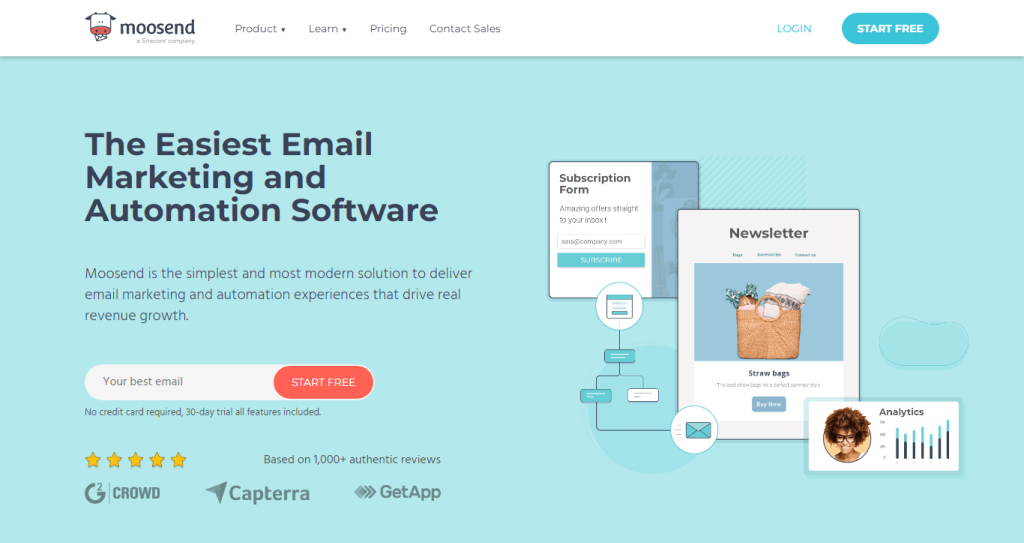
You can easily get started on Moosend. The platform allows you to send up to 2,000 emails free of charge. The basic, free version includes a drag-and-drop design approach, and email delivery is efficient.
With Moosend, you can get important insights into consumer behavior and upgrade to a more advanced version at any time. Additionally, its advanced automation allows you to program specific emails for over 100 hundred triggers, which is pretty impressive.
10. Reachmail
Reachmail is known for having customizable email templates and detailed analytics that make improving your campaigns significantly easier. Besides its free version, it has three different paid plans—Bronze, Silver, and Gold—ranging between $10 to $70 per month.
It offers alternative solutions based on your online store’s size and high-volume senders. The company also has support staff on hand to guide you as you develop your email strategies. Excellent customer service is what sets this provider apart from other email service providers.
11. Mailchimp

One of the most popular email marketing tools available is Mailchimp. To quote the software provider: “Even if you don’t know the first thing about marketing — we provide world-class technology and support to help your online business launch, build, and grow to meet your one-of-a-kind vision.”
This platform offers three different plans: the New Business Plan, the Growing Business Plan, and the Pro Marketer Plan. The New Business Plan is free, while the Pro Marketer Plan costs $199 per month. Although not cheap, its marketing resources help you stay informed and ahead of your competition.
12. GetResponse
GetResponse offers plenty of unique features that make this platform stand out, not least of which is the landing page creator and the ability to engage contacts through live webinars. Like other platforms, it offers A/ B testing, segmentation, and the use of dynamic content for better personalization and engagement.
It has a free trial plan for 30 days, after which its cheapest plan is $15 per month. GetResponse also has a premium package. This all-inclusive solution is perfect for mid and large companies looking for advanced marketing tools, dedicated support, and top data security. Otherwise, its free-forever plan is perfectly suitable for brand-new businesses wanting to incorporate email marketing into their digital marketing strategies.
13. Mailjet
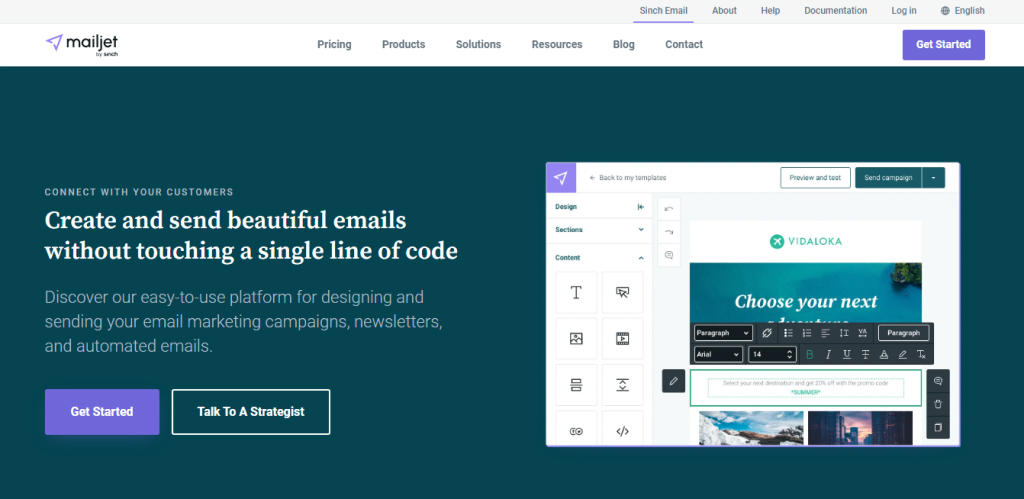
Mailjet is an email service provider that works with brands like Microsoft and Etsy to help create, send and optimize marketing and transactional emails. Founded in 2010 in France, it sends over one billion emails every month. Its free version allows you to send 6,000 emails on a monthly basis. You can also take advantage of the platform’s 30-day trial of its premium version as well.
Mailjet’s intuitive user interface is available in French, English, German, Spanish, and Italian. Its drag-and-drop email builder lets you create 100% responsive emails in no time. For even more customized content, you can insert HTML code blocks from the platform’s interface and collaborate with other users in real-time.
14. MyBizMailer
Start by using MyBizMailer’s free option or upgrade to one of three paid versions. MyBizMailer has prices and packages for every sender type. Pay-as-you-go, subscriber-based plans, send-based plans, and high-volume plans mean you never have to break the bank. MyBizMailer’s prices are the lowest on the market, so you can advertise on any budget.
The platform allows for contact management, branded emails, and premium reporting free of charge. It also offers a dedicated IP, so you can have a special internet address that’s only used to send emails. For high-volume email senders, this provides full control and optimization of your IP to ensure your emails land in the right inboxes.
15. HubSpot
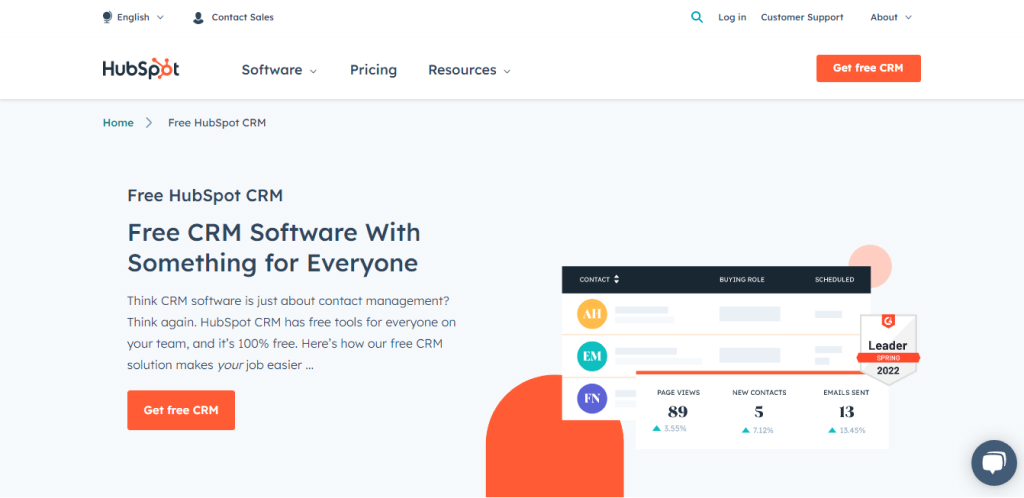
The most renowned emailing marketing tool, besides MailChimp, is HubSpot. Because HubSpot’s free email hosting tools are built on top of a CRM, your emails will always be powered effortlessly by customer data, resulting in better results and ROI. As such, the platform provides the most value for businesses that want in-depth data and tracking to guide their eCommerce email campaigns.
HubSpot’s contact database shows you a subscriber’s lifecycle stage, their memberships, and any other pertinent information contained in their contact record. With this information, you can send email subscribers the most relevant subject lines, tailor content to their pain points, and provide them with marketing information they’ll engage with.
How to Create Email Campaigns That Don’t Annoy Consumers
Timing is crucial when it comes to the success of your eCommerce email marketing. Sending an email (and its response) reveals facts about your relationship with your customers. Click-through rates in some industries can be as low as 2%, so you have to be strategic in your approach.
To determine how often to send out email campaigns, consider your industry, what your competitors are doing, and the nature of the email. Regardless of your email’s intention, it should always provide value for your customers.
Some eCommerce businesses send less than three emails per month, while others send messages multiple a week. There isn’t an exact science or target to meet; it depends on your industry and your business goals.
If you have no idea where to begin, you can experiment by sending weekly, bi-weekly or monthly emails. Remember, you have to start sending emails to gather customer data. Once you have a better idea of how customers respond and what their preferences are, you can tweak your campaign accordingly.

Implement a Professional Email Marketing Strategy
With the right digital marketing team on your side, you can transform email marketing into one of your eCommerce business’s biggest assets. Comrade Digital Marketing specializes in email marketing for a range of businesses, delivering high-performance campaigns that capture target audiences and take them on a carefully curated journey to become loyal customers. If you need assistance with your email marketing or any other aspect of digital marketing, we can help! Contact us to improve your marketing messages.




